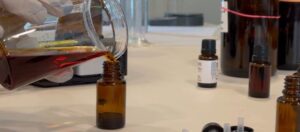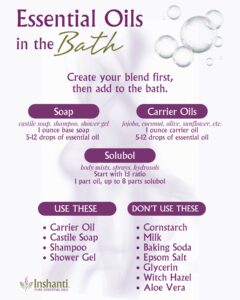If you’re looking to maximize the potential therapeutic benefits of your essential oils, there are several fun and creative options. One such idea is “dilution blending,” which is combining a single or multiple essential oils with a carrier oil or other substance to reduce their concentration and enhance the synergistic benefits.
If you’re new to blending, please read this Beginning Guide to Blending first.
Dilution Percentages
It is essential to understand how to intentionally blend oils together for an enhanced synergistic effect. If you’re new to blending, first, please check out our blog on blending basics. Below are percentages to help you strategize your blending.
Examples of Dilution
- 1 fl oz (30 ml) of carrier
- 1% Dilution: 5–6 drops total
- 2% Dilution: 10–12 drops total
- 3% Dilution: 15–18 drops total
- 2 fl oz (60 ml) of carrier
- 1% Dilution: 10–12 drops total
- 2% Dilution: 20–24 drops total
- 3% Dilution: 30–36 drops total
Customized Blends
- Low Dilution for Sensitive Situations
For emotional issues, pregnant women, children, chronically ill individuals or those with compromised immune systems, use a 1% dilution. This equates to 5–6 drops of essential oil in 1 fl oz (30 ml) of carrier oil.
- Moderate Dilution for Regular Use
For massage oils and daily applications, opt for a 2% dilution. This means incorporating 10–12 drops of essential oil in 1 fl oz (30 ml) of carrier oil.
- Targeted Relief for Injuries and Ailments
Adjust dilution to 3–10% depending on factors like individual tolerance, age, and severity of the issue. A 3% concentration (dilution) would involve 15–18 drops of essential oil in 1 fl oz (30 ml) of carrier oil. Blends at this percentage are used for 1-2 weeks in an acute situation.
- Focused Solutions for Specific Conditions
Increase dilution to 3-10% for localized problems, such as chest congestion. For instance, a 10% dilution would require 50–60 drops of essential oil in 1 fl oz (30 ml) of carrier oil.
- Intensive Support for Acute Cases
In cases of acute and severe issues like intense muscle cramps or significant bruising, a short-term 25% dilution may be used, although it’s rarely necessary.
- Direct Application in Emergency Situations
In small, localized, and acute situations like headaches or superficial cuts, undiluted essential oil can be used. Ensure the oil is of the highest quality and skin-friendly, and limit usage to short-term needs.
Bath Blending
Aromatherapy baths are a popular way to enjoy essential oils. However, here at Inshanti, we suggest – science first! That way, you can feel confident in enjoying the benefits of your aromatherapy bath.
First, essential oils are not water-soluble, meaning they do not dissolve in water. If you pour them directly into your bathwater, the oils will float on the surface, heat up, and attach themselves to your skin, causing stinging and irritation.
For safe, enjoyable and effective use of oils in your bath, please disperse them safely. Comfortable essential oil dilutions in a bath depend on the person and the specific oils, so you have to experiment to learn what dosage your body responds to most favorably.
 Key Tips for Bath Blending
Key Tips for Bath Blending
- It’s important to be specific about which oils to use in a bath. Use only oils that have no skin irritation and safety concerns.
- Create your blend first. Then, add it to your bath. See below for base suggestions.
- Castile soap, baby shampoo or shower gel. For a 1 oz base, use about 5-12 drops of essential oil, depending on the skin safety of the essential oil.
- Carrier oils (jojoba, coconut, olive, sunflower, etc.). Mix 5-12 drops of essential oil per 1 ounce of your chosen base. Please keep in mind that any carrier oils can make your bathtub slippery.
- Solubol, which is a dispersant for essential oils in water-based systems like body mists and sprays which are high in water or hydrosols. Start mixing at a 1:1 ratio, then add more solubol until the essential oils are fully incorporated or solubilized, which may require a dilution ratio of 1 part essential oil to up to 8 parts solubol.
- If you’re adding Epsom or regular salts, add the salt to the bath before or after your blend.
- Disperse your blend separately to avoid the hardening of the Castile soap.
- Enjoy your bath!



